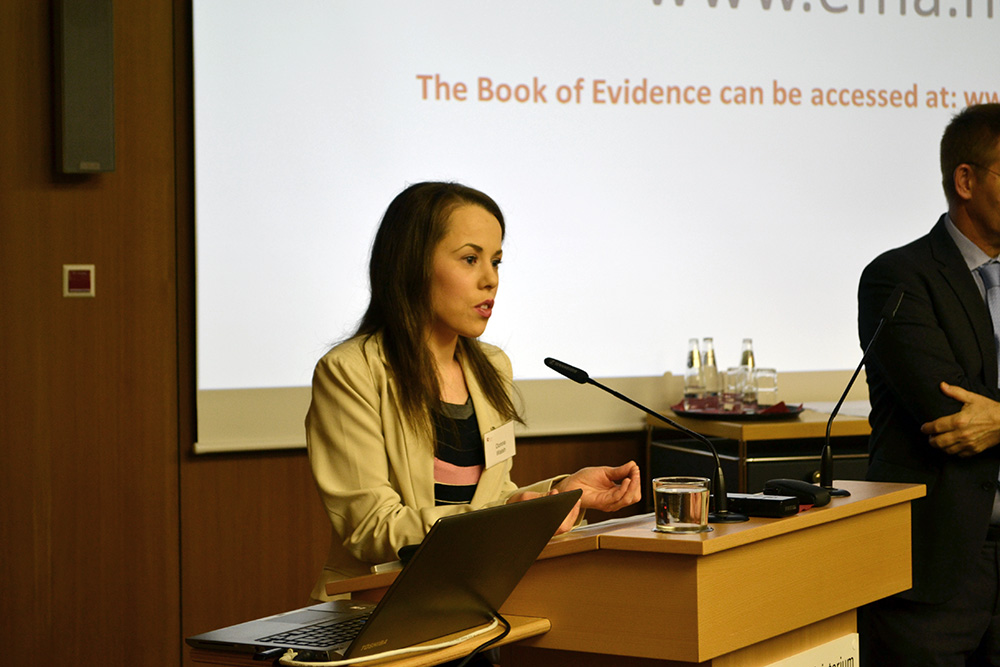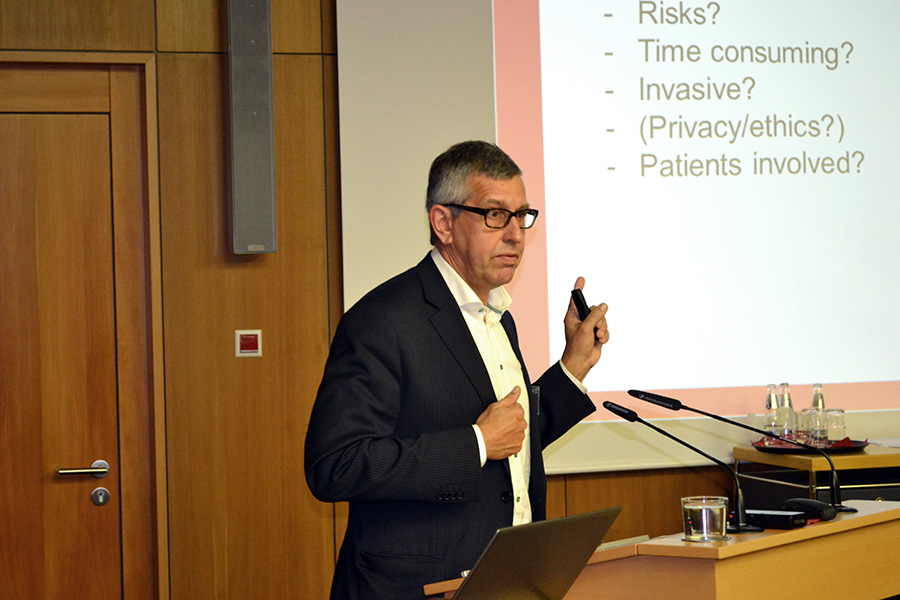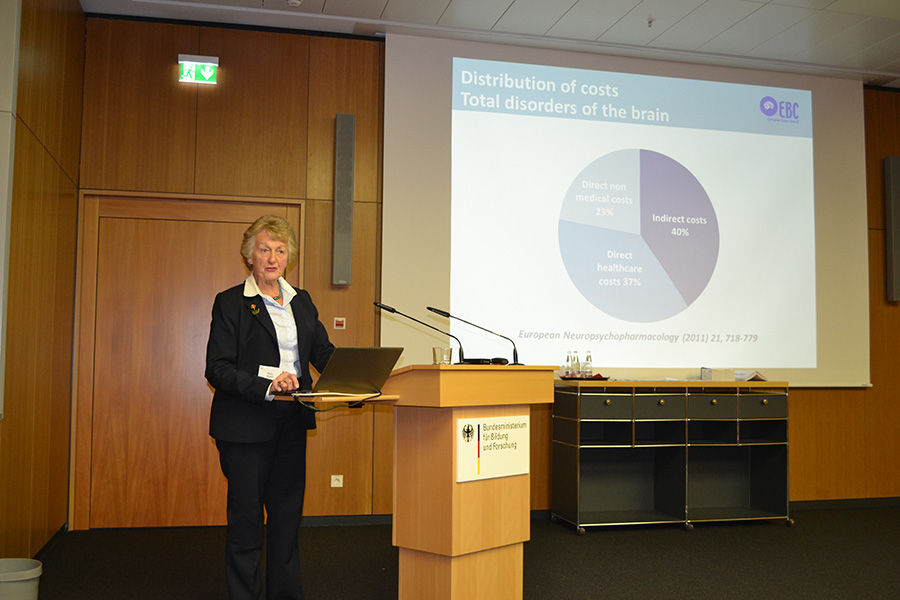Brain Research: Symposium in Berlin on January 12, 2016
How to reinforce the interactions between scientists, clinicians and the society in the field of brain research?
At the recent January meeting ERA-NET NEURON was braced for a wider day of interaction. Stakeholders from European scientific organizations, including lay organizations, came together to discuss alignment of basic and clinical disciplines. Leading European neurologists, psychiatrists and neuroscientists met at the symposium ‘How to reinforce the interactions between scientists, clinicians and the society in the field of brain research?’ on January 12th, 2016. The experts discussed how to improve research collaboration between clinicians and basic scientists and how to involve patients in research activities.
The presidents of the European Academy of Neurology and of the European Psychiatric Association, Günther Deuschl and Wolfgang Gaebel highlighted the clinical perspective. The president of the Federation of European Neuroscience Societies, Monica di Luca, presented the basic researchers’ view. Donna Walsh, Executive Director of the European Federation of Neurological Associations, and Raluca Nica of the Global Alliance of Mental Illness Advocacy Networks – Europe explained how the lay organizations in the field of neurology and psychiatry work with the basic scientists and the clinicians to fight neurological and psychiatric disorders. The connection to policy making bodies was illustrated by Mary Baker, immediate past president of the European Brain Council.
All were invited by ERA-NET NEURON, which creates a strategic platform to address brain disorders that impose a particularly high burden of disease. According to estimates by the World Health Organization, more than one billion people suffer from diseases of the brain and the nervous System. In ERA-NET NEURON 27 ministries and funding organizations across Europe, Israel, Turkey and Canada have joined forces to support basic, clinical and translational research in the diverse fields of disease-related neuroscience.

The topic is hot because the complexities of brain diseases require new paradigms of interactions to tackle the most pressing research questions. Clinicians and researchers – neurologists and psychiatrists – already enface the challenges of the demographic change in the area of brain diseases: ‘fewer to care for more’. The role and participation of patients in research and evidence-based healthcare might thus be reformulated to active involvement in the planning phases of research approaches, the execution of services and the maintenance of standards of healthcare. Or, as Etienne Hirsch and Bernard Poulain, the organizers of the ERA-NET NEURON symposium put it ‘The topic of this symposium represents an emerging important and challenging aspects of science’.
Disclaimer: The DLR Project Management Agency organised this event in their function as ERA-NET NEURON coordinator. The DLR Project Management Agency has agreed to upload the presentations held during this event on this website for download subject to the express consent of the speakers concerned. The DLR Project Management Agency as the uploading entity has not monitored the contents of these presentations in any way. In case of incorrect contents, copyright infringements or other violations of the law, please contact neuron-eranet@dlr.de. Any offending material will be removed immediately.

The symposium was opened with a ‘General overview on the Strategic Research Agenda’ (SRA) of ERA-Net NEURON by Martin Dichgans. The chair of NEURON’s advisory board explained the SRA – framework that will guide NEURON’s future activities aiming to improve prevention, diagnosis, and treatment of diseases affecting the nervous system. Recommendations from the SRA are intended to set the stage for the type and topics of the future joint calls and other enabling activities. Martin Dichgans is the Director of the Institute for Stroke and Dementia research (ISD) at Ludwig-Maximilians University, Munich, Germany. Research at ISD aims at improving options in early recognition, prevention, diagnosis and treatment of stroke and dementia. The focus is on disease mechanisms and prevention while integrating basic and patient-oriented research.

The President of the Federation of European Neuroscience Societies (FENS), Monica Di Luca, highlighted researcher’s responsibility to develop novel tools and approaches in order to integrate and advance knowledge. Di Luca pointed out that at the same time this bears ‘Opportunities to provide a better understanding of the underlying pathogenic mechanisms of brain diseases, and thus to generate novel therapeutic approaches for the benefit of society’. Monica Di Luca strongly advocated the importance of fundamental research in this endeavor as fundamental research goes hand in hand with understanding the diseased brain.
In the second part of the symposium, special emphasis was put on how to reinforce the links between the professional communities: from bench to bedside. Priorities of neurologists and psychiatrists were discussed by Günther Deuschl and Wolfgang Gaebel.

In his talk ‘Priorities for neurology “the point of view of the neurologists”’ Günther Deuschl, head of the Neurology Clinic at the University Hospital of Schleswig-Holstein, Germany and president of the European Academy of Neurology explained the necessity to increase the availability of diagnostic and treatment standards by e. g. guidelines and spreading education. Reinforcement for the diagnosis and treatment of neurologic diseases could be achieved by the use of practice oriented methodology (GRADE), and collaborations with subspecialty societies, neighboring societies and patient organizations. He is confident that a better understanding of the disease mechanisms will benefit early diagnosis and understanding of disease progression to improve health outcomes for neurological disorders.

Wolfgang Gaebel, head of the department of psychiatry and psychotherapy, Heinrich-Heine University and LVR-Institute of Healthcare Research, Düsseldorf, Germany and president of the European Psychiatric Association (EPA) shared the view about ‘Priorities for Psychiatry “the point of view of the psychiatrists”’. He hypothesized that ’Neurologic and psychiatric research are moving closer together in the tools they use, the questions they ask, and the theoretical frameworks they employ. The interests of neurology and psychiatry converge within the framework of modern neuroscience.’ Consequently, potential areas of fostering the interactions between scientists, clinicians and society comprise a) the participation of lay organizations in scientific congresses, b) the presence of brain/mental health research related publications in mass media and social networks, c) joint statements regarding ‚hot‘ topics like e.g. refugee mental health, d) joint positions against stigmatization and discrimination of people with brain/mental disorders, e) the participation of representatives of lay organizations and policy makers in guideline development committees like e.g. the European Guidance project of the EPA, and f), not least, the joint development of policy recommendations.


Janine Blom from the Netherlands Organisation for Health Research and Development (ZonMW) and Martin Boer, Director of the Epilepsy Foundation provided insights into a successful collaboration between funding agencies, researchers, clinicians and lay organizations. As Blom detailed: ‘Patient involvement in an assessment procedure could be to evaluate the relevance of a specific grant application for patients’. The installment of an additional ‘end-user’ panel within the grant application review process may delay the entire assessment process. However, the benefit for the concerned patients excels the potential delay. A grant had been awarded by ZonMW Translational Research and the Dutch Epilepsy Fund for a project from Utrecht University. Both speakers concluded that ‘Stakeholder involvement works! New insights into programs and proposals are gained, assessment process and proposals benefit from better quality, and yet unmet needs are adressed’

Donna Walsh, Executive Director European Federation of Neurological Associations (EFNA) addressed in her contribution the question of how the lay organizations in the field of neurology can work with the basic scientists and the clinicians to fight neurological disorders. She stressed the benefits of Patient-Public Involvement (PPI) as follows: helping to identify and prioritize the most patient-relevant topics, identifying cultural issues that should be taken into account, suggesting the best way to get informed consent from patients and/or carers, ensuring that information sheets, questionnaires and interview schedules are patient-friendly, speeding recruitment by providing researchers with better access to the patient community, and, not least, helping to disseminate results through patient-led advocacy, relating research findings to patients’ own experience, and presenting them in a more user-friendly manner.

In the area of psychiatric disorders, Raluca Nica from the Global Alliance of Mental Illness Advocacy Networks – Europe (GAMIAN Europe) explained the activities of this patient-driven pan-European organization. Besides advocacy on behalf of psychiatric patients for respecting the rights of the patients the agenda of GAMIAN comprises information, education, and training for patients with psychiatric illnesses and the general public, anti-stigma and anti-discrimination campaigns, and co-operation and partnerships with other NGOs, professional associations, pharmaceutical companies and decision making bodies. In an overview of the key conceptual and social issues that psychiatry is facing today she pointed out that patients often improve substantially, but many do not recover fully. Thus, experts and practitioners now recognize the need to incorporate multiple dimensions (severity, distress, impairment) into their assessment procedures to better accommodate advances in relevant basic brain and behavioral sciences, and to enhance clinical relevance. It is regarded as strength that the field is scientifically committed to both optimizing treatment outcomes and personalizing treatment for those living with psychiatric disorders. This commitment led to the creation of models of care (e.g. depression care management) that allow evidence-based practice to reach both specialized mental health and general medicine settings.

The very important ethical aspects of patients’ and professionals’ relationships were presented by Hervé Chneiweiss, President of INSERM Ethical board. He reasoned that ethical issues raised by neuro-technologies are not necessarily unique or exceptional, but the significance of the brain in human existence generates powerful reasons, both, to intervene when function is damaged and to proceed with caution before intervening without good evidence of safety and benefit. Therefore, ensuring public confidence in novel neuro-technologies will be crucial. In turn, this will require collaborative public engagement activities involving both, researchers and clinicians, coupled with strong governance procedures and effective regulation. As in every scientific area: new knowledge creates new challenge. Some novel knowledge in neuroscience feeds public/media/politicians imagination about possible brain manipulation, but may also change our approaches to education, moral judgment, decision-making. Because scientific and technological developments are crucial for brain research and treatment of brain disorders, it is not surprising that exactly these gains in knowledge play a central role in ethical issues, notably informed consents in the actual research context and associated consequences.

The symposium continued with a presentation by Mary Baker of ‘How to speak to politicians to engage countries in the fight for prevention of brain disorders’. She explained the importance of prevention at the primary, personal level: Both, parental guidance and the education system are crucial for a healthy future for the mind and the body. Baker, immediate past President of the European Brain Council (EBC) detailed that future medicine proceeds from ‘Today we diagnose and treat based on symptoms and a subjective interpretation of symptoms to the future in which we diagnose and treat based on biology and select medication based on an objective evaluation of the benefit/risk for the individual patient’. She highlighted the importance of patient reported outcomes to focus researchers and clinicians on the issues that are really relevant to improve the situation of the afflicted persons. The concept of ‘Personalised, Predictive, Preventive, Participatory’ (P4) medicine is picked up by e.g. e-Health and emerging technologies via computer models of diseases and decisional systems based on models for selecting treatments and performing earlier diagnosis – VPH (virtual physiological human). Mary Baker concluded her talk with the words ‘A healthy nation is a wealthy nation.’ a statement that should be put forward to policymakers when advocating for investments into brain research.

The concluding presentation ‘Horizon 2020 and brain research’ was given by Catherine Berens, Head of Sector Neuroscience of the European Commission. Brain disorders pose a global challenge at all age groups. Along these needs, EU-funded brain research in the 7th Framework Programme amounted to 3 billion Euros. The Horizon 2020 area ‘Health, Demographic change and Well-being’ intends to translate science to benefit citizens, moves on from a disease-oriented approach towards personalized medicine to better depict biological variations, and provides more opportunity for brain research. The first Horizon 2020 brain collaborative projects are worth more than 350 million Euros. Within the 2016-2017 work programme several opportunities are offered for brain research. Besides specific topics, Small & Medium sized Enterprises (SME) instruments, the Innovative Medicine Initiative (IMI2) and other international and multi-lateral cooperations like InTBIR were exemplified.
Conclusions: As Etienne Hirsch summarized: ‘Altogether, this symposium emphasized the increasing awareness of patient involvement in brain research’. The symposium stressed the needs and challenges because it must individually be decided – along the specific disease area researched and corresponding patient groups – what is the most appropriate type of participation. For instance, lay organizations can be key partners in clinical trials. There is however a need to educate patients and scientists on why patient involvement in research is necessary and how it can be put into practice. Such efforts should be directed towards the current lack of experience, education and awareness on both, patient/lay organization and scientists/clinicians sides. Benefits of successful involvement range from patient-friendly information sheets, questionnaires and interview schedules to better recruitment, and better dissemination of results. During the ‘after work’ reception lively discussions took place. It was highly appreciated that this symposium brought scientists from very different areas together with ministry and funding agency representatives.
Impressions
One of the key-elements of ERA-NET NEURON is the support of excellent research. Since 2008 research grants of more than 80 million euros were provided for multinational projects in various areas of research into brain function and its disorders. More than 300 research groups from Europe, Canada, and Israel pursue their research plans in 76 funded consortia. The output from these consortia in terms of enhanced knowledge and improved diagnostic measures and therapies is impressive. With a new joint transnational call launched on January 11, 2016, BMBF together with its international partners in the ERA-NET NEURON and the European Commission, supports research in the area of traumatic brain and spinal cord injury. In total around 20 million euros are allocated to this funding initiative. Violent insults to the head and body can result in complex injuries to the brain or spinal cord with a broad spectrum of symptoms and severe disabilities. The impact on afflicted persons and their families can be devastating. The initiative aims to increase our understanding of the disease and help develop better diagnostic, therapeutic and rehabilitative measures.








